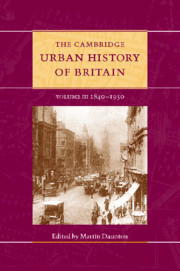1 - Introduction
Published online by Cambridge University Press: 28 March 2008
Summary
CIRCULATIONS
In 1850, Charles Dickens received a gruesome gift from his brother-in-law, Herbert Austin – the Report on a General Scheme for Extra-Mural Sepultre. This nauseating account of densely packed urban graveyards exuding noxious gases, secreting foul fluids, turning the soil ‘black and pitchy’ and making the boundary wall ‘damp, glutinous and spongy’ led Dickens to dream of putrefaction. But his imagination had been stimulated even before reading Austin’s sickening report, for his novels were obsessed with graveyards and slaughterhouses, sewers and cess pits, their textures and secretions, described in the same language as the reports of sanitary reformers. Dickens portrayed early Victorian London as permeated with notions of decay, corruption, stench and stickiness. The city of Dickens and the sanitary reformers, at the beginning of the period covered by this third volume of the Cambridge Urban History, was rotten, stagnant, putrefying – a place of blockage where the frustration of circulation resulted in secretions and miasmas. The language of Dickens and sanitary reformers provided imaginative force to a real and alarming crisis in British towns and cities at the opening of Victoria’s reign, bringing a variety of problems together into a single frame of reference and uniting otherwise disparate issues in a way which justified action and intervention. As Christopher Hamlin has remarked, the monumental infrastructure of sanitation inserted into Victorian towns was ‘even more remarkable as an achievement of public persuasion than one of bricks and mortar’.
Keywords
- Type
- Chapter
- Information
- The Cambridge Urban History of Britain , pp. 1 - 56Publisher: Cambridge University PressPrint publication year: 2001
References
- 5
- Cited by

